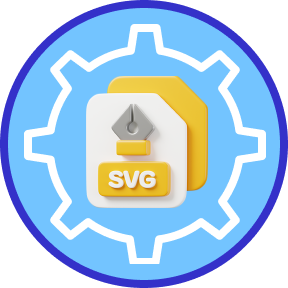Click the Choose Files button and pick your SVGs files.
Choose options for Optimize and Click on the Optimize button to begin the Compression.
Status changes to Done; click the Download button to Download Optimized SVGs.
Once you download the SVGs, click Reuse Tool or Delete the File.
1 Easy to Use - Optimize SVG tool is straightforward to use.
2 Quality Options - You have Quality Options to choose from. When Optimizing, the most excellent SVG quality.
3 Optimizing the SVG tool is entirely complimentary and at the same time website is safe and secure; you can use the tools limitlessly. When you use the tools and process the files, after the conclusion of the procedure, your files are kept in our server for 15 minutes, and the files get eliminated immediately after 15 minutes. Or, once the file is downloaded, you can erase your file yourself by clicking the stop button.
4 Optimize SVGs tool works on any web internet browser with a safe HTTPS connection. You can Optimize your SVGs without stressing about file security and personal privacy.
5 Files Size - The optimum file size is 250 MB; you can process 250 MB files by sending them in one process; however, you can do it as many times as you want with all tools. The use of all tools is endless and free.
1 The history of the SVG file goes back to the late 1990s when the Web Consortium (W3C) welcomed propositions from developers for a brand-new kind of vector graphic format. Six competing proposals were sent and assisted notify what ultimately ended up being the W3C's SVG format.
2 Scalable Vector Graphics (SVG) is an XML-based vector image format for specifying two-dimensional graphics, assisting interactivity and animation. The SVG specification is an open basic established by the Web Consortium (W3C) in 1999. However, SVGs took a while to grow in popularity.
3 There was relatively little assistance for them till 2017, when people began to see the advantages of using SVGs in modern-day web browsers. SVG files are now extensively used for 2D site images since many internet browsers and drawing apps for vector files can quickly manage them.
1 Scalable Vector Graphics (SVG) is a web-friendly vector file format. Instead of pixel-based raster files like JPEGs, vector files save images via mathematical solutions based upon points and lines on a grid.
2 This indicates that vector files like SVG can be significantly resized without losing their quality, making them perfect for logo designs and complex online graphics. It's not simply their resizing abilities that make SVGs extremely popular with web designers.
3 SVGs are written in XML code, meaning they keep any text details as literal text instead of shapes. This enables online search engines like Google to read SVG graphics for their keywords, which can help a site increase search rankings.
4 You can quickly spot an SVG file by its .svg extension.
1 Unlike raster files, which are comprised of pixels, vector graphics like SVGs maintain their resolution-- no matter how big or small you make them. You don't need to fret about SVG images losing their quality in specific web browsers or when you resize them to appear in different places.
2 Basic SVG files are typically smaller than raster images, constructed from lots of colored pixels rather than mathematical algorithms.
3 Because SVG files treat text as text (and not as style), screen readers can scan any words included in SVG images. This is helpful for people who require help reading webpages. In addition, an online search engine can also read and index SVG image text.


